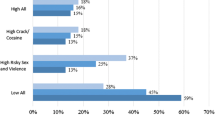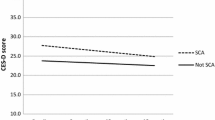Abstract
This study uses longitudinal data to identify “risk markers” for reassault among batterer program participants. Data are from 308 men and their partners collected at five, 3-month intervals. Time-varying situational and behavioral risk factors, as well as time-invariant individual characteristics, are examined. The most influential risk markers, in terms of relative risk and level of statistical significance, were time-varying: 2 measures of the man's drunkenness during the follow-up interval in which the reassault occurred (OR: 3.5-16.3; p > .0005). Other included time-varying batterer characteristics had no significant effect on reassault. Two significant time-invariant batterer risk factors were (1) severe psychopathology and (2) a history of non-domestic-violence arrest, both measured at intake. Results suggest that batterers' drinking behavior after program intake may provide an important and easily observed “marker” for risk of reassault and that prediction of reassault with individual risk factors at program intake remains problematical.
Similar content being viewed by others
REFERENCES
Dutton, D., and Starzomski, A. (1993). Borderline personality in perpetrators of psychological and physical abuse. Viol. Vict. 8: 327–337.
Gondolf, E. (1995). Alcohol abuse, wife assault, and power needs. Soc. Serv. Rev. 69: 275–284.
Gondolf, E. (1999). A comparison of four batterer intervention systems: Do court-referral, program length, and services matter? J. Interpers. Viol. 14: 41–61.
Gondolf, E. (1997). Patterns of reassault in batterer programs. Viol. Vict. 12: 373–387.
Hamberger, L. K., and Hastings, J. (1990). Recidivism following spouse abuse abatement counseling: Treatment program implications. Viol. Vict. 5: 157–170.
Hart, B. (1995, March). Coordinated Community Approaches to Domestic Violence, Paper presented at the Violence Against Women Research Strategic Planning Workshop, National Institute of Justice, Washington, DC, March 31.
Holtsworth-Munroe, A., and Stuart, G. (1994). Typologies of male batterers: Three subtypes and differences among them. Psychol. Bull. 116: 476–497.
Hotaling, G., and Sugarman, D. (1986). An analysis of risk markers in husband to wife violence: The current state of knowledge. Viol. Vict. 1: 101–124.
Kantor, G., and Straus, M. (1987). The “drunken bum” theory of wife beating. Soc. Probl. 34: 214–230.
Kenkel, Donald, S., and Ribar, David, C. (1994). Alcohol consumption and young adults' socioeconomic status. In Brookings papers on economic activity: Microeconomics, Brookings Institute, Washington, DC, pp. 119–175.
Liang, K., and Zeger, S. (1986). Longitudinal data analysis using generalized linear models. Biometrika 73: 13–22.
Lidz, C., Mulvey, E., and Gardner, W. (1993). The accuracy of predictions of violence to others. J. A. M. A. 269: 1007–1011.
Millon, T. (1994). Millon Clinical Multiaxial Inventory–III, National Computer Systems, Minneapolis, MN.
Monahan, J. (1984). The prediction of violent behavior: Toward a second generation of theory and policy. Am. J. Psychiatry 141: 10–15.
O'Campo, P., Gielen, A., Faden, R., Xue, X., Kass, N., and Wang, M. (1995). Violence by male partners against women during the childbearing year: A contextual analysis. Am. J. Public Health 85: 1092–1097.
Rice, M. (1997). Violent offender research and implications for the criminal justice system. Am. Psychol. 52: 414–423.
Saunders, D. (1995). Prediction of wife assault. In Campbell, J. (ed.), Assessing the Risk of Dangerousness: Potential for Further Violence of Sexual Offenders, Batterers, and Child Abusers, Sage, Newbury Park, CA, pp. 68–95.
Saunders, D. (1996). Feminist-cognitive-behavioral and process-psychodynamic treatments for men who batter: Interaction of abuses traits and treatment model. Viol. Vict. 11(4): 393–414.
Selzer, M. (1971). The Michigan Alcoholism Screening Test (MAST): The quest for a new diagnostic instrument. Am. J. Psychiatry 3: 176–181.
Steadman, H. J. (1982). A situational approach to violence. Int. J. Law Psychiatry 5: 171–186.
Straus, Murray, A. (1979). Measuring intrafamily conflict and violence: The Conflict Tactics (CT) Scales. J Marr. Fam. 41: 75–88.
Straus, Murray,A. (1990). The Conflict Tactics Scale and its critics.An evaluation and new data on validity and reliability. In Straus, M. and Gelles, R. (eds.), Physical Violence in American Families, Transaction Publishers, New Brunswich, NJ, pp. 49–76.
Tolman, R. M., and Bennett, L. W. (1990). A review of quantitative research on men who batter. J. Interpers. Viol. 5: 87–118.
Author information
Authors and Affiliations
Rights and permissions
About this article
Cite this article
Jones, A.S., Gondolf, E.W. Time-Varying Risk Factors for Reassault Among Batterer Program Participants. Journal of Family Violence 16, 345–359 (2001). https://doi.org/10.1023/A:1012268725273
Issue Date:
DOI: https://doi.org/10.1023/A:1012268725273




